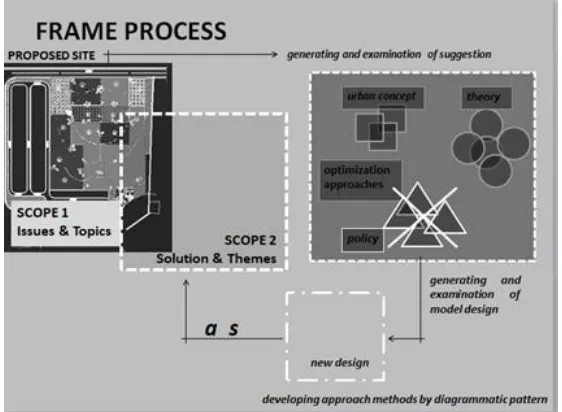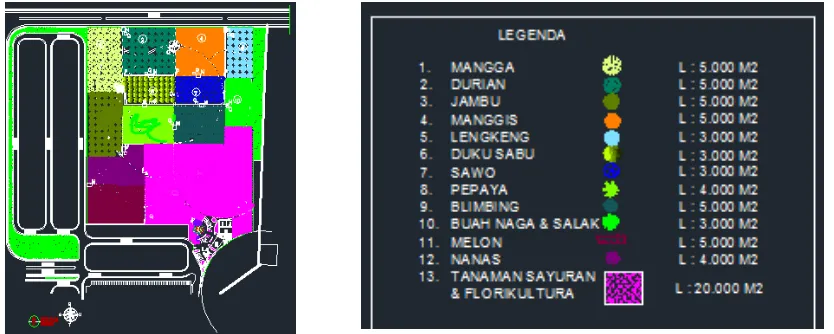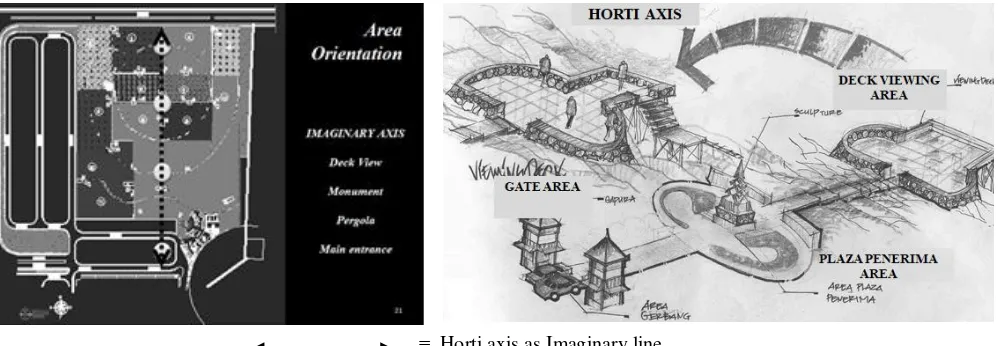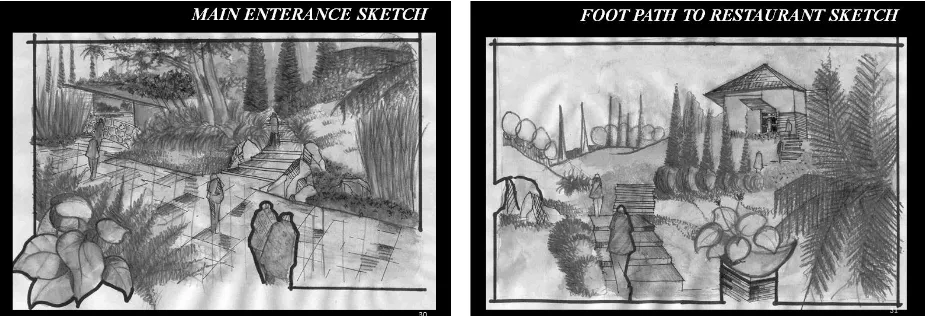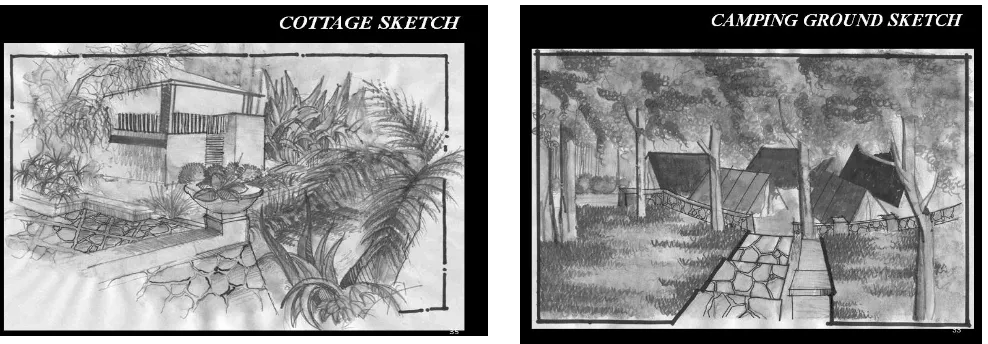Hortipark Lampung as environmental friendly urban
horticulture concept in Lampung Province
K H Basuki 1, R Widyawati2 and S N Khotimah2
1. Architecture Department, the Faculty Engineering, the University of Lampung, Indonesia
2. Department of Civil Engineering, Lampung University, Lampung, Indonesia
corresponding author’s e-mail: jaya_setika@yahoo.com
Abstract. There are negative sides of city expansions and rapid urbanization such as the decline of green open space, pollution, natural disaster, etc. Hortipark Lampung as an urban horticulture is one of the solutions for those bad effects of urbanization especially in Lampung Province. The planning of Hortipark Lampung was designed for harvest, open space creation, aesthetic, architectural, recreational and psychological purposes. In designing the Hortipark Lampung, existing condition of proposed site was observed. Some approaches also were applied in designing Hortipark; (1) environmental approach, (2) tourism approach and (c) educational approach. By comparing the urban concept and related theories and applying optimization approach the new design of Hortipark Lampung was proposed.
Keywords: Environmental Friendly Urban Horticulture, Hortipark Lampung
1. Introduction sustainability [4]. The urban sustainabilty may happen as UH is one of the best practices which help urban citizen to have more open space and green infrastructure [5], to control stormwater, urban heat island effect, to adjust species habitat, to reduce waste production, to robust food security [7] to raise incomes, employment, to improve environmental quality [1].
Hortipark Lampung which functions as UH in Lampung Province, Indonesia, is located in Sabah Village. The village is in the outskirt of Bandar Lampung City, the Capital City of Lampung Province. Hortipark Lampung was a project initiated by local government to provoke horticulture growth in the area. Before the study, the Hortipark was just a bare land with fence as a barrier from other surrounding areas. Its original design was just focus on horticulture development. For these reasons, the park needed to have a new design which has multifunctional schemes. Urban Horticulture with its multi-functional roles has recently become a globally important topic. It is considered as an approach to address the emerging challenges to societies seeking greater sustainability [4].
robust food security and adding a large open space near the developed area (Bandar Lampung City). Based on Franchino (2015) [8], urban farming can make a valuable contribution as an effective instrument for renewable of urban open space because offers significant possibilities from an environmental, economic and social perspective. The park also has a mission as an educational media for children and young generation for environment awareness. The park is also designed for people amenity, enjoying the park for recreation.
In this study, some goals were set to achieve: (1) optimum landscape design, (2) create comfortable agro-tourism, (3) identify people movement by having good circulation within the park.
2. Research Methods
For developing a new design of Hortipark Lampung which carrying multifunctional objectives (as: an urban horticulture area, a Lampung tourism excellency, and an environmental educational area), there were steps done in the study, those are:
1. Analyzing existing/previous design.
2. Finding solution and theme to reach the three main functions of the park. 3. Proposed a new Hortipark Lampung design
2.1. Analysing existing/previous design
In this step, some aspects were reviewed. For example, the aspects of history that were carried in the existing design, the policy of local government regarding the development of Hortipark, the previous facilites exist in the park, etc. After analyzing those aspects, then proceed to determine which aspects were retained or compromised for the new design of Hortipark Lampung.
2.2. Finding solution and theme to reach the three main functions of the park
Solution and theme in this study already formulated, that was as a park with three main functions; as: an urban horticulture area, a Lampung tourism excellency, and an environmental educational area. To achieve this solution, the step done by gathering urban concept and theory followed by optimization approaches (Figure 1.).
Figure 1. Frame process to have a new design for Hortipark Lampung
2.3. Proposed a new Hortipark Lampung design.
3. Result and Discussion
3.1. Study area
Hortipark Lampung is located in Sabah Village, South Lampung Regency. It is the outskirt of Bandar Lampung City, the Capital City of Lampung Province, Indonesia. Hortipark Lampung has about 7 Ha of area.
The area of South Lampung Regency is located between 105º14 'to 105º45' East Longitude and 5º15 'up to 6º South Latitude. Such a location, shows that South Lampung Regency include to the tropics area. South Lampung regency is an area traversed by the traffic flow from Sumatra and Java Islands. The Regional Planning and Development Agency (BAPPEDA) of Lampung Province stated in 2012 that every day an average of 800 tons of agricultural products, plantations and basic necessities from Sumatra are sent to Jakarta (and some areas in Java) through Bakauheni Crossing South Lampung.
Hortipark Lampung was a project initiated by local government to provoke horticulture growth in the area. Before the study, the Hortipark was just a bare land with fence as a barrier from other surrounding areas. There was mangosteen monument as a symbol of horticulture.
3.2. Previous design
The previous design of Hortipark Lampung can be seen in Figure 2. From the picture, it can be seen that the Hortipark were divided into some zones as seen as coloured zones. The pink zone in this area proposed as vegetables area while for the rest, were designed as orchard zones.
Figure 2. Previous Hortipark design
3.3. Proposed design
The proposed design was a result of urban concept and theory gathering and optimization approaches. The macro and micro concept of region were analyzed to create a new comfortable Hortipark Lampung design. The proposed design of Hortipark Lampung can be seen in Figure 3.
On a macro scale, architecture deals with urban planning (town planning, to transportation planning, urban / rural planning), landscape planning, urban design. While in the micro scale starts from the interior room planning to the building including exterior and landscape.
3.3.1. Functional Approach.
the design to create Lampung tourism excellency. The approach is assimilated by hortipark arrangement of the beauty of the orchard and vegetation species diversity. The beauty arrangement is expected to become a tourist attraction of the city, family tourism. Education approach is implemented by designing the augment of education facilities to make young generation gaining knowledge of environment especially about horticulture so that children be more concern and aware to the environment.
Figure 3. Proposed Hortipark design
3.3.2. Basic Concept of Regional Establishment of Hortipark Lampung 3.3.2.1. Regional Establishment
The basic concept of regional establishment of the park was gained by combining the four important elements forming the region, namely; (1) image, (2) integration, (3) accesibility and (4) function. An image here is an effort to form a new image for visitor, an image of “a park for horticultural
cultivation but gives visitor for amenity, enjoyment and educational place”. An integration means an effort to integrate the region in macro and micro level whether local, regional or national. Hence the region can become one-unit integration with other regions. An accessibility is a way to manage the easiness to reach the park from other places. A function, the park was developed as a multifunctional place/activity hence the purpose of the region can be achieved. The regional scenarios depends on the formation regional aspect: land ownership, location, accessibility, and issue that developed.
3.3.2.2. Direction of Hortipark Lampung Development Pattern
Hortipark Lampung is a large area. To avoid lost feeling in the park, the park was designed to have an
imaginary axis called “Horti Axis” by linking together viewing deck, mangosteen monument and main
entrance as one line as binding point (Figure 4.).
= Horti axis as Imaginary line
3.3.2.3. Circulation in Hortipark Lampung
Circulation system is closely related to the pattern of activities placement and land use. Hence it is the way to manage the movement from one place to other places. A poor circulation will make uncomfortable movement in the area. For example: the absence of space division for vehicle and pedestrian circulation. For enjoyment, the hortipark Lampung circulation was designed by distributing vehicle circulation and pedestrian.
3.3.3. Exterior Design of Hortipark Lampung
For exterior design of Hortipark Lampung shown in Figure 5. From the figure, it can be seen that vegetation may play role as some function, such as: director, room maker, shelter, room partition.
3.3.4. Space Concept
Space concept of Hortipark Lampung shown in Figure 6 and Figure 7. The new design of Hortipark for new facilities consist of main enterance, foot path, screen house, camping ground, cottage.
Figure 5. Various function vegetation design in Hortipark Lampung
Figure 7. Space Concept in Hortipark Lampung
4. Conclusion
To realize Hortipark area in South Lampung Regency with good planning, proper, efficient and sustainability, it is necessary to formulate a design plan of Hortipark Area in Sabah Balau Village of South Lampung that can accommodate the interests of development of facilities and infrastructure of hortipark area as well as cultivation which contains directives and recommendations in determining the technical policy of regional development. In formulating the design of Hortipark Lampung with the objective, it is necessary to formulate the initial strategy that can be a direction in the preparation, both technical and non-technical.
References
[1] Aubry, C.; Ramamonjisoa, J.; Dabat, M.H.; Rakotoarisoa, J.; Rakotondraibe, J.; Rabeharisoa, L. Urban agriculture and land use in cities: An approach with the multi-functionality and sustainability concepts in the case of Antananarivo (Madagascar). Land Use Policy 2012, 29, 429–439.
[2] Peñaranda, R. M., Japan’s Urban Agriculture: Cultivating Sustainability and Well-being, March 17th, 2018, https://unu.edu/publications/articles/japan-s-urban-agriculture- what-does-the-future-hold.html
[3] Sioen, G., B., Terada, T., Sekiyaman, M., Yokohari, M., Resilience with Mixed Agricultural and Urban Land Uses in Tokyo, Japan, Sustainability 2018, 10, 435.
[4] Chou, R. J., Wu, C. T., Huang, F. T., Fostering Multi-functional Urban Agriculture: Experiences from the Champions in a Revitalized Farm Pond Community in Taoyuan, Taiwan, Sustainability 2017, 9, 2097
[5] Sanesi, G.; Colangelo, G.; Lafortezza, R.; Calvo, E.; Davies, C. Urban green infrastructure and urban forests: A case study of the Metropolitan Area of Milan. Landsc. Res. 2017, 42, 164– 175.
[6] Dielman, H., Urban agriculture in Mexico City; Balancing between ecological, economic, social and symbolic value. Journal of Cleaner Production
[7] Napawan, N. C., Burke, E., Productive Potential: Evaluating Residential Urban Agriculture. Lands. Res. 2016, 41,773-779.
[8] Franchino R., The use of urban farming in sustinable regeneration interventions of anthropized areas. HoPUE - Housing Policies and Urban Economics, 2015; vol.2; 99-108.
